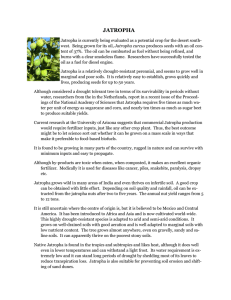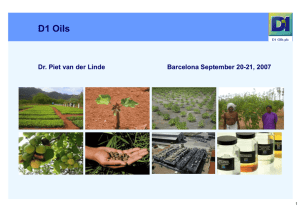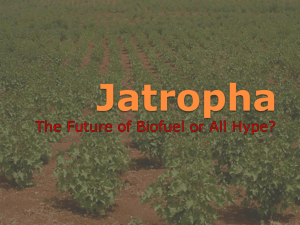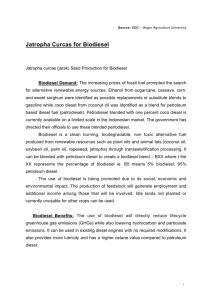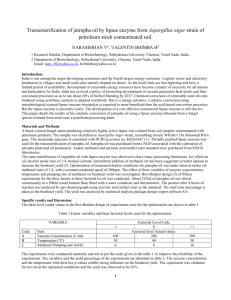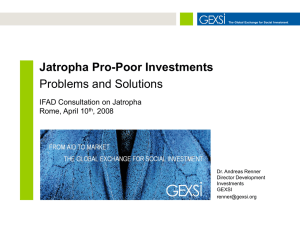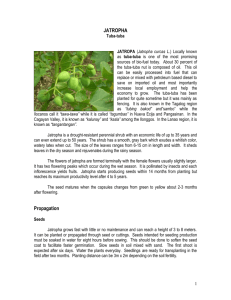Usage of Treated Wastewater for Bio-fuel Production Ahmed Al-Busaidi
advertisement
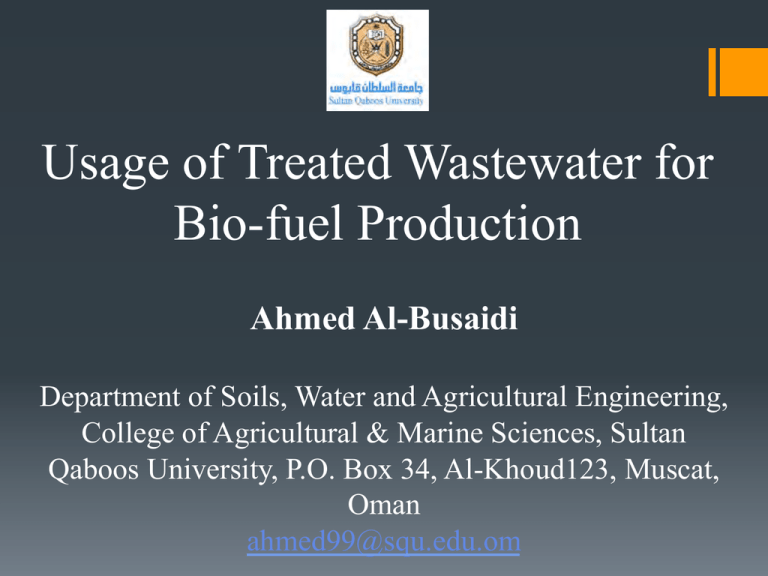
Usage of Treated Wastewater for Bio-fuel Production Ahmed Al-Busaidi Department of Soils, Water and Agricultural Engineering, College of Agricultural & Marine Sciences, Sultan Qaboos University, P.O. Box 34, Al-Khoud123, Muscat, Oman ahmed99@squ.edu.om Definition of Biofuels fuels derived from biomass: plant material, crop energy, or agricultural and forestry wastes and byproducts used as energy source. Examples Sunflower oil Coconut oil Palm oil Rapeseed oil Why use Biofuels Fossil fuel: § Limited § Carbon dioxide § Production § Rural economy Bio-fuel: § Renewable, Biodegradable § Efficient § Engine Friendly § Healthier § Carbon Neutral § Job generation Global warming Biofuels World Biodiesel - World European Community USA EU China 4% 4% R.o.W 4% USA 50% Brazil 38% Brazil Malays 2% R.o.W ia 15% 3% Indone sia USA 4% 16% EU 60% Source: F.O. Licht; FAO (2008) Biofuels Rapeseed oil Soybeans Sunflower oil Palm oil Coconut oil Global Water Resources • World population food production limited fresh water resources What Is Jatropha (a biofuel crop)? § Jatropha (Jatropha Curcas) is an excellent biofuel crop which has many other advantages over existing c r o p s . The hardy Jatropha is resistant to drought and pests, and produces seeds containing up to 40% oil. When the seeds are crushed and processed, the resulting oil can be used in a standard diesel engine, while the residue can also be processed into biomass to power electricity plants. Not only does it have a great yield of well over 2,000 barrels of oil per square mile per year, it also increases the fertility of the land. Jatropha absorbs large amounts of carbon dioxide from the atmosphere and therefore earns carbon credits Jatropha Seeds Bio-fuel Extraction: mechanical & chemical Daimler South East Asia introduces test fleet of 10 smart city vehicles for a two year trial (Jatropha trials are powered by CSMCRI’s biodiesel) First ever project of its kind - Singapore is the only test site worldwide (Aug 18, 2008) The Chemistry of Transesterification It is simple enough but few seem to be getting it right! O CH2-O-C-R CH-O C-R O CH2-O-C-R O TRIGLYCERIDE MeOH Catalyst 3 R-C-OMe O Methyl ester having chain length similar to that of diesel (BIODIESEL) + CH2-O-H CH-OH CH2-O-H GLYCEROL Toyota Qualis has successfully completed till date 120,000 km on neat biodiesel without engine modification CSMCRI Jatropha by-product Jatropha plant with fruit Jatropha deoiled Cake Crude Glycerine Jatropha seeds Jatropha biodiesel wastes Blend film 0 day PHA film 0 day PHA film after 50 days Blend film after 90 days Biodegradability of PHA in the moist garden soil Bacterial Inoculum Jatropha biodiesel production plant PHA powder PHA film 1838/DEL/2009 dated 7 Sept 2009 Microbial heterotrophic production of bioplastic utilizing Jatropha biodiesel residues as sole nutrients Marine bacteria MTCC-5345 isolated from Indian waters India Develops Plastics from the Jatropha Plant April 9, 2010 A new, potentially important, source of bioplastic has been discovered in Indiathe Jatropha plant, which is already being processed to produce diesel fuel. The Salt and Marine Chemical Research Institute (CSMCRI) of Bhavnagar, India is using a local microbe to produce plastic from the glycerol byproduct of biodiesel production..... Doug Smock Materials Editor, Design News www.designnews.com Needham, MA Hot Climate Area: 309,500 Km2 *Arid Country with annual rainfall of 100 mm * Annual Evaporation: 7,714 MCM * Groundwater is the main source of water Sectoral Water Use in the Sultanate A gric ultural 90% (1491 MCM/Y r) Domes tic 7% (117 MCM/Y r) Indus trial 0.6% (9 MCM/Y r) Munic ipal 2.4% (40 MCM/Y r) Total Demand = 1657 MCM/Y r 1800 Water Balance in the Sultanate (MCM/Yr) 1267 Supply Demand 1657 Deficit WD AW 1990 1995 Deficit 1400 Water (MCM) 390 1600 1200 1000 800 600 400 200 0 1985 2000 2005 Year 2010 2015 2020 2025 Seawater Intrusion Pressure Pressure Salt Affected Area of Oman = 44.18% Salinity in CWANA countries 20.0 Central & West Asia & North Africa 18.0 Salinity at Country Level 16.0 Pauw (2001) Qatar Turkmenistan Iran Uzbekistan 14.0 12.0 United Arab Emirates Egypt 10.0 Kuwait 8.0 Tunisia 6.0 Kazakhistan Oman 4.0 Afghanistan 2.0 te s Eg yp Ku t w a Tu it n Ka za isia kh ist an O Af m a gh an n ist an M or o Ta cco Sa jikis ta ud iA n ra bi a Jo rd a Al n ge ria Sy ria Li b Ky rg ya yz st W Le a n es ba te no rn Sa n ha ra te d Un i ira Ira Em Ar ab Uz b q Saudi Arabia Ira ek n ist an Tajikistan rk m 0.0 Qa ta en r ist an Morocco Tu % of land area Iraq Jordan Algeria Syria Wastewater treatment plants > 402 20 Muscat STP water STP water (m3/day) 250,000 200,000 150,000 100,000 50,000 0 2005 2010 2015 2025 Standards of Effluent expected Haya values from Concession Haya STPs Agreement Class A (agricultural irrigation permissible limits) (115/2001) Parameter Units BOD mg/l <15 <5 15 TSS mg/l <15 <5 15 Total N as N mg/l <15 <15 - NO3 as N mg/l - <11.3 11.3 Total P as P mg/l 30 < 30 30 Faecal Coliforms MPN/100 ml < 200 < 200 200 Viable Helminth Ova Number /L <1 <1 <1 Residual Chlorine at customer point mg/l 0.3 < x < 1 - Water from Samail STP Parameters Value EPA FAO Standard Standard Omani Jordanian Saudi Standard Standard Standard BOD (mg/l) <MDL 15 15 15 15 10 pH 7.60 6-9 6.5 – 8 6-9 6-9 6 – 8.4 EC (dS/m) 1.37 2.3 0.7 - 3 2 - 2.7 2 – 2.5 3 – 3.5 N-NH4 (mg/l) 0.22 5 5 5 5 5 TSS (mg/l) 7.00 15 15 15 50 10 N-NO3 (mg/l) 0.00 50 5 - 30 50 30 10 Oil & Grease (mg/l) 0.90 5 0.50 0.50 8 0.0 Coli forms (cell/100 ml) 0 200 100 200 100 2.2 E-Coli (cell/100 ml) 0 200 100 200 100 2.2 Water from Nizwa STP Sample 1 Sample 2 Cd < 0.001 < 0.001 0.01 0.01 0.01 0.01 0.01 Co 0.001 0.002 0.05 0.05 0.05 0.05 0.05 Cu 0.009 0.018 0.50 0.20 1.00 0.20 0.40 Cr 0.002 0.003 0.10 0.10 0.05 0.10 0.10 Fe 0.014 0.017 5.00 5.00 5.00 5.00 5.00 Pb 0.005 0.009 0.10 5.00 0.20 0.20 0.10 Mn 0.002 0.002 0.20 0.20 0.50 0.20 0.20 Mo 0.002 0.006 0.01 0.01 0.05 0.01 0.01 Ni 0.039 0.031 0.10 0.20 0.10 0.20 0.20 V 0.004 0.002 0.10 0.10 0.10 0.10 0.10 Zn 0.016 0.036 5.00 2.00 5.00 5.00 4.00 Parameters ml/l EPA FAO Standard Standard Omani Standard Jordanian Saudi Standard Standard Bio-fuels Needs LAND LABOR TECHNOLOGY WHAT IS NECESSARY TO PRODUCE BIOFUELS? GOVERNMENT SUPPORT CLIMATE Objectives § To evaluate the ability of Jatropha plant to grow and survive under saline irrigation (GW & TWW) and heat stress condition. § Study the interactive effects of these factors on seed production and oil quality. To make a qualitative but critical analysis of the expected sustainability of bio-diesel production from Jatropha, with the main focus on the environmental sustainability under Oman conditions. Materials and Methods The pots experiments were carried out in Agricultural Experiment Station at the College of Agricultural & Marine Sciences, Sultan Qaboos University, Oman. Treatment (36 pots) Growth condition Saline irrigation ) (fresh water, 3 & 6 dS m-1) (glasshouse ,shadehouse and open area Irrigation = ETC Soil & Plant parameters were monitored and measured Result & Discussion Temperature data for the three experimental sites 45 Glass house Shade house Temperature (oC) 40 35 30 25 20 15 Apr-09 Jun-09 Jul-09 Month Aug-09 Open field Jatropha growth under different environmental conditions Result & Discussion Soil salinity and moisture content as affected by different treatments (G: glasshouse, S: shade house, O: open field, C: control, S3: salinity at 3dS/m, S6: salinity at 6dS/m). Result & Discussion Plant parameters under different growth conditions (G: glasshouse, S: shade house, O: open field, C: control, S3: salinity at 3dS/m, S6: salinity at 6dS/m). Result & Discussion Jatropha leaf area and root weight as affected by different treatments Result & Discussion Analysis of variance (ANOVA) for soil and plant parameters. Parameter Mean Square 0.32 F Sig. pH Sum of Squares 7.24 9101.69 0.00 Soil EC 3583720 155813.9 4.78E+08 0.00 MC 1690.75 73.51 3277612 0.00 Plant weight 2071645 90071.53 3.94E+09 0.00 Root weight 142498.1 6195.57 2.71E+08 0.00 R/S ratio 47.68 2.07 92421.66 0.00 Height 98328.18 4275.19 1.87E+08 0.00 Leaf Area 291853.5 12689.28 5.66E+08 0.00 Growth of Jatropha after transplanting Excellent Growth Fatty acid composition of crude Jatropha oil Melting Point oC Wt (mg/g) of Jatropha oil - 0.012 54 0.070 Palmitoleic Acid (C16:1) - 0.034 Pentadecanoic Acid (C15:0) - 21.120 Palmitic Acid (C16:0) 63 0.001 Linoleic Acid (C18:2) -5 60.754 Oleic Acid (C18:1) 16 54.806 Stearic Acid (C18:0) 70 8.368 - 0.181 Fatty Acid Azelaic Acid (C9:0) Myristic Acid (C14:0) Arachidic Acid (C20:0) Monounsaturated fatty acids 54.844 polyunsaturated fatty acids 60.753 saturated fatty acids 285.661 Total fatty acids content 401.258 2nd study Jatropha growth as affected by irrigation water quality, intervals and fertilizer application Jatropha growth as affected by irrigation water quality, intervals and fertilizer applications (fwc: freshwater control, fwo: freshwater organic, fwin: freshwater in organic, Tw: treated wastewater, 3, 6, 9: EC dS/m of saline water). Jatropha growth in wasteland (rocky and saline) irrigated with treated wastewater, freshwater and saline water (3 dS/m). Treated wastewater freshwater saline water (3 dS/m) Treated wastewater freshwater saline water (3 dS/m) Treated wastewater freshwater saline water Growth of Jatropha in wasteland (rocky and saline) irrigated with treated wastewater, freshwater and saline water (3 dS/m) Conclusion * This experiment indicated that a good management of soil and water and selecting the best growth condition could be a viable option for sustainable agriculture with minimum loss in plant production. * The study concluded that both saline and treated waste waters supported Jatropha growth. * Treated waste water has high nutritional values compared to fresh water. Therefore, it can improve soil and plant conditions. * Good seed production from Jatropha plants with good opportunity for bio-fuel production opened a good window for bio-fuel production using treated waste water in hot and dry regions like Oman. Green Award Usage of waste Recourses (Rocky Soil & Treated Wastewater) Good Growth of Jatropha Biofuel

